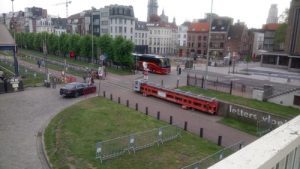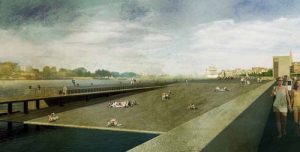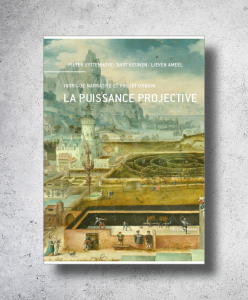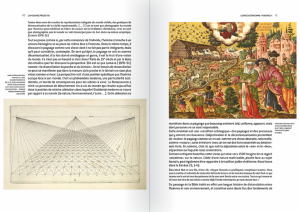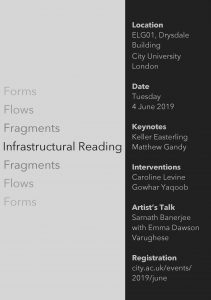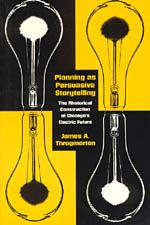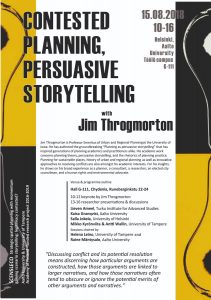Really glad to see the latest article in my research of future narratives of cities at the water, “Agency at/of the waterfront in New York City: Vision 2020 and New York 2140” just being published in Textual Practice. The article approaches the question of narrated agency in future narratives through the lens of the New York waterfront, explored as a site for enacting and critiquing the possibility to act towards the future. Who is described as having the possibility to act at the waterfront, and to what extent is the water seen as a force in its own right? These questions are addresses by examining two key texts imagining a future New York City: the New York Comprehensive Waterfront Plan Vision 2020 (2011) and Kim Stanley Robinson’s New York 2140 (2017). I argue that both texts gesture towards an acknowledgement of possible agency of the water, while continuing to reiterate an instrumental relationship with the environment that focuses on processes of appropriation, distribution and production. Ultimately, this article considers the implications for the implied readers’ agency, and for their possibilities to take meaningful action to interact with, and make changes in, their relationship with the water.
Ameel, Lieven 2019. “Agency at / in the waterfront in New York City: Vision 2020 and New York 2140.” Textual Practice. ahead of print
https://www.tandfonline.com/doi/full/10.1080/0950236X.2019.1581250
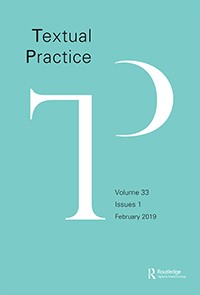
From the introduction:
“The future, in the words of Bertrand de Jouvenel’s The Art of Conjecture – a founding textbook of futures studies – constitutes a ‘field of uncertainty’ and a ‘field of liberty’ – the domain of the not-yet, onto which everyone is free to project anything one wants. But the future is also a ‘field of power’, and, as de Jouvenel points out, ‘the future is our only field of power, for we can act only on the future’ (emphasis added). In a time of global warming and radical climate change, I would add, the future has also become the field of both a shared and individual ethical responsibility. Examining narratives of the future is one important way to address this interplay between uncertainty, liberty, power, and responsibility. From literary fiction to planning and policy visions, narratives frame, question, and shape the future and our possibilities to act upon it. Crucial for how different forms of storytelling act as storehouses of knowledge with which we approach the future is the question of agency. Who is described as possessing the possibility to act, and how is this ability carried out?
This paper approaches the question of narrated agency in future narratives through the lens of the New York waterfront, explored here as a site for enacting and critiquing the possibility to act towards the future. In the texts examined here, the urban waterfront appears as an arena of transformation, both in material and in allegorical terms, the place where the city’s – and city dwellers’ – coming-of-age rituals are performed time and again. But this is also an area where the water itself appears as a force in its own right, acting upon the environment. The texts examined here are the New York Comprehensive Waterfront Plan Vision 2020 (2011) and Kim Stanley Robinson’s New York 2140 (2017).”
From the conclusion:
“Rather than an optimistic and ‘surprisingly utopian’ view of human defiance, as some critics have it, I would argue that New York 2140 offers a bleak examination of the limits set to action by monetary structure, and the power of financial liquidity to embrace even the noblest of causes and have them enmeshed in the ebb and flow of global finance. Such a view is in part compatible with a range of recent research, critical of the prose novel’s affordances to describe meaningful possibilities for action beyond the immediate personal circle. Similarly, Vision 2020 can hardly be blamed for doing what a planning document is supposed to do: setting out how it will order, arrange, and develop the planning area for the overt benefit of its citizens (and that of the less explicated vested interests jostling for predominance). If neither of these two texts give exactly cause to celebrate the possibilities to act towards a better future of and at the waterfront, Vision 2020 and New York 2140 do provide a number of insights. Citizens can act, in Vision 2020, to propose change, protected as they are by the New York charter and in the form of ‘197-a plans’ that enable communities to initiate development initiatives. In both texts, the water can be thought of as possessing legal status and independent agency, even if only as a thought experiment. The waterfront, even if relentlessly reclaimed, appropriated, redistributed, capitalised upon, does retain a measure of its transformative power regardless; a sense of openness from which a new order can arise, only partially shaped by conscious and intentional efforts – and so does the future.”
Thanks to everyone at the research seminar of comparative literature, University of Turku, and Tintti Klapuri, in particular, for helpful comments. Thanks are due also to the anonymous reviewers.
Many thanks to everyone at Textual Practice for excellent work on the volume and providing a stimulating forum for literary research.
If anyone from Taylor & Francis is reading along: Textual Practice is a Taylor & Francis journal. The recent developments (time of writing: February 2019) in the dispute between Taylor & Francis and Finnish national and university libraries have caused me, and most academic researchers I’m aware of, to reconsider whether or not we will want to continue publishing in Taylor & Francis journals. Current publishing practices are not sustainable and a move to increased open access publishing will be necessary, hopefully in collaboration with publishers and with university research assessment schemes.



